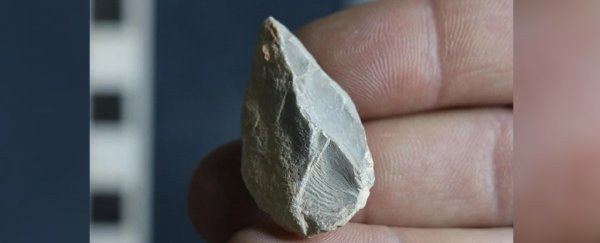Exactly when and how our species reached the Americas remains a messy historical conundrum. A heated debate has now ensued amongst archeologists in the face of conflicting evidence between archaeological finds and genomic data.
Possible stone tools, reported earlier this year, spurred excited headlines suggesting humans may have arrived in this region as early as 30,000 years ago – before the last ice age.
Autonomous University of Zacatecas archaeologist Ciprian Ardelean and colleagues examined 1,930 limestone shards found at the Chiquihuite Cave site in Zacatecas, Mexico, concluding they were stones chiseled into tools by human hands.
They also tested surrounding environmental DNA, and while they did find some genetic traces of humans, it was not enough to draw firm conclusions.
Another team of researchers, led by archaeologist James Chatters from the private company Applied Paleoscience, has since argued that the stones in question could have been shaped by natural processes.
"In the high-energy cliff-face environment where Chiquihuite Cave is found, falling and tumbling rocks strike one another and drive off shards, which often have some of the features of rocks broken by people," Chatters told Gizmodo.
"A stone striking a stone can produce similar looking products regardless of how the force is initiated."
The patterns of flaking on the stones are not consistent with those seen in stone tools from other archaeological sites, where they're flaked on both sides. Nor is there any evidence of impact fractures to show they'd been used as tools, the researchers said.
Chatters and team, however, "did not inspect the collection in-person but instead relied strictly on the evidence provided in the original article and supporting documentation."
Still, other signs of human occupation are also absent from the caves, like hearths, food waste, and other modified animal remains. What's more, all the 'tools' were made from the same type of stone, where usually humans would experiment with all available options, such as the agate nearby.
Chatters and colleagues argue there is not enough evidence that these rocks were indeed human-made tools, and would therefore dispel the theory that humans first settled in the Americas only around 16,000 years ago, which was after the last ice age.
They cite unmistakable human-made artifacts, supported by genomic evidence from both humans and their accompanying canine friends that all point to this timeline instead.
Establishing the time of this human migration would also provide clues to the path they took, and whether or not humanity's presence coincided with the loss of North America's megafauna.
"Although they do not elaborate on all of the extraordinary implications of such an early occupation, we posit that this would mean humans were present in northern Mexico at a time prior to the initial divergence of ancestral Native Americans and East Asians, which occurred in eastern Asia," Chatters and team state in their critique, explaining this would have meant that these early Americans were a genetically distinct group that somehow left no genetic traces in the human populations that followed.
"This extraordinary claim requires substantial evidence to support it."
In response to this, Ardelean and colleagues point to ancient unsampled human populations that have contributed to present Native American genes.
They claim Chatters and team have misunderstood their results, arguing that expecting all artifacts to have the same chipping pattern ignores more basic technologies that may have also been used.
What's more, just a few months ago, human footprints found in New Mexico's White Sand National Park were dated as far back as 23,000 years ago.
Another recent study found 30,000-years-old animal remains that could have been deposited by humans, in Mexico's Coxcatlan Cave. So it doesn't appear as if we can completely rule either scenario out quite yet.
Ardelean and team are currently working on analyzing excavations that took place after those analyzed in last year's paper, promising that "more specialized use-wear analyses are in process."
There's more to come on this story, that's for sure.
The critique and its response were published in PaleoAmerica.
